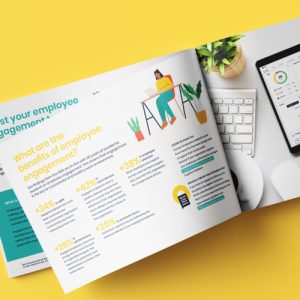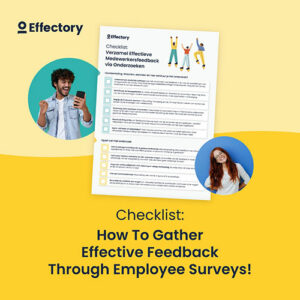Results from our global employee survey reveal that less than two thirds of employees experience a good work-life balance. In light of this, I would like to discuss how HR and managers can help employees improve their work-life balance.
Just 65% of employees experience a good work-life balance

Many employees these days want to have the complete package. A good career, a comfortable salary, an active social life and time for family. Attempting to have all four is somewhat of a juggling act, and it isn’t easy. Although juggling several things at once isn’t an issue, employees can and often do get the juggling act wrong.
When employees get this juggling act wrong, their work-life balance becomes imbalanced. Our work at Effectory International shows us that having a long-term work-life imbalance can cause serious problems from short term stress, to a loss of physical well-being, all the way to burnouts and long term sickness.
How to create a good work-life balance
Switching off
One of the main causes of recent work-life imbalances has been the huge advances in technology. Whilst the advances have undoubtedly made our lives easier, it has also made it more difficult for employees to switch off from work and take time out.
Every day I take a 2 hour commute to work on train, and each day, I take a look around at my fellow commuters. Nearly everyone is on their smartphone checking their emails, Facebooking, Tweeting or keeping up to date with current affairs. I will also admit that I’m guilty of this and although my smart phone has made my life easier, it’s also made it harder to stop working.
Being online 24 hours a day means that employees spend more time working than they may realise. Even when on holiday, employees keep up to date with what’s happening in the office and although it may seem innocent, it reduces the time employees are switched off from working. Whichever way you look at it, the boundary between work and home has increasingly become blurred.
Global Employee Engagement Index™
A comprehensive overview of employee engagement with benchmarks from 57 countries with essential lessons for your HR strategy .
DownloadSkewed priorities
In addition to technology, I also believe that too many employees are too focused on work. Ask any employee what’s important to them, and I’m almost certain that the majority will say happiness, family, friends etc. In spite of this, it’s clear from employees’ behaviour that many employees are geared towards prioritising their work life over other areas.
How to increase productivity in employees
If employees really want to ‘have it all’ it’s vital that they understand that in order to be able to successfully juggle work, family and friends, they need to pay attention to other areas of their life than just work.
Two hidden aspects
Closely related to the two aspects mentioned above, work environments also play a key role in an employee’s work-life balance and employee’s vitality. Generally speaking, there are two types of work environments that are most problematic.
The first working environment is perhaps surprisingly, a driven and stimulating working environment. Within environments where there is a great deal of drive, enthusiasm and where employees are highly engaged, there lies a hidden risk. That risk is that employees become so enthusiastic that they are unable to take time away from work and manage their workload.
Alongside driven and stimulating work environments, the second dangerous work environment is one of toxicity and high pressure. In a toxic environment employees are subjected to a work environment where the energy levels and atmosphere are extremely negative, there is bad management, excessive hierarchy and unreasonable office politics. If an employee has a high pressured job and is stuck in a toxic environment, their work-life balance is often slowly worn down until breaking point.
Employee experience in 3 easy steps
Learn the best ways to improve the employee experience in your organization with these 3 easy-to-follow tips! Get your copy today!
Download: employee experience tipsAreas of concern
Our latest global employee survey revealed that 65% of employees responded positively to the statement I experience a good balance between my work life and my private life. Of the 65%, just 18 % strongly agreed and 47% agreed.
Industry analysis reveals that employees in the service industry, automation and production experience some of the worst work-life balance. At the other end of the scale, employees in administration and support, and business services experience the best work-life balance.
Helping employees manage their work-life balance
Although employees have the responsibility for their own work-life balance, there are several ways in which managers and HR can help them. The following six points can be implemented by managers and HR to help employees.
1. Check with employees on a regular basis and keep in regular contact with them. It may sound simple, but small and informal meeting provide managers with the perfect platform to create an open dialogue around the issue.
2. Work on creating an environment of trust. In doing so, employees will be more forthcoming about any work-life issues.
3. Ensure that employees’ personal situations are taken into account. A good example is offering employees more freedom when their personal situation requires, which in turn will create the flexibility required for a good balance.
4. Offer employees specific training courses. Whilst employees have a great deal of influence of their work-life balance, they may need help in creating a healthy work-life balance.
5. Create a work pressure meter in the office. Having a visible gauge on how employees are doing really helps to create awareness about the issue and furthermore, keeps the topic out in the open.
6. Consider offering employees more flexible working hours and the possibility of working from home from time-to-time. An increase in freedom will enable employees extra mobility so that unexpected occurrences like a child’s illness or dentist appointment, doesn’t become unnecessarily stressful.
How to gather feedback from your employees
The definitive checklist for creating your employee engagement survey.
Download

